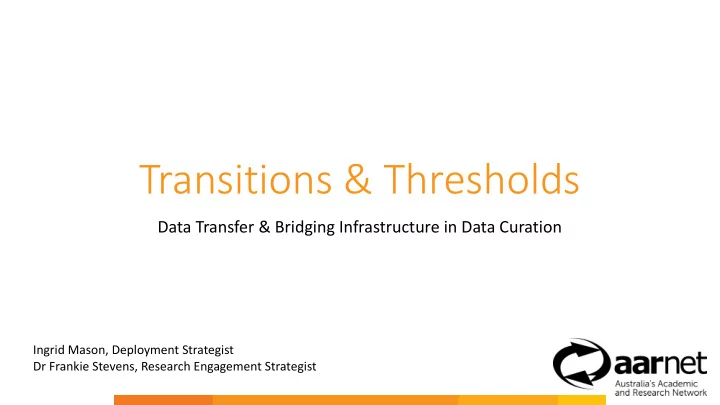

Transitions & Thresholds Data Transfer & Bridging Infrastructure in Data Curation Ingrid Mason, Deployment Strategist Dr Frankie Stevens, Research Engagement Strategist
What happens “in between”… the stages of this [curation] lifecycle model, the where and the how, of data packaging and movement, that supports
Propositions • By bringing forward the transitions, the “in between” stages (or thresholds) of the DCC lifecycle model we see critical points in data curation as part of research workflows, and the complex relationships around and technologies that support those activities • By inspecting data transfer and bridging infrastructure we begin to understand how that binding matter*, as with the high-speed networks, reflect the processes, partnerships and communities, in the Australian research landscape. *Advanced research networks and their layered services now including cloud storage have sometimes been referred to as: the dark matter binding the research universe
By shifting the lens this way… The less evident data transfer and bridging infrastructure layer (implicit in the [curation] lifecycle model) that enables data use and curation, is highlighted.
Assertions • Many researchers will be moving their data in/out research infrastructures and into a “third space” and “binding matter” and bridges enable this • Curation support for the bulk of data and technology intensive research is undertaken in ad hoc, semi-manual processes rather than enabled with guidance and systematic technology enabled workflows • A panoptic view of multiple disciplinary research workflows (between institutional boundaries) is needed to ascertain where existing research support and infrastructure* can be broadly applied and reused, and where new research support and infrastructure is needed *standards, procedures, policies, processes, guidelines, people, applications, systems, services etc
Kicking off a research project 1. Packaging 2. Movement
We begin to understand… how that binding matter, as with the high-speed networks, reflect the collaborations, partnerships and communities, in the Australian research and education landscape.
Kicking off a research project 1. Packaging 2. Movement
Transitions & Relationships • Create • Receive • Facility rep and researcher • Data store rep and researcher • Intra/extra institutional • Intra/extra institutional • Local/remote access • Local/remote access
Data Packaging and Movement https://www.flickr.com/photos/neuwieser/4827571943/ CC-BY-SA 2.0 https://www.flickr.com/photos/stevendepolo/5162503281/ CC-BY 2.0
Analysis of lifecycle models [they] encourage thinking that research processes are highly purposive, uni- directional, serial and occurring in a closed system. Research is often not like this,… [they are] used to explain service offerings, the analysis shows that this may not always reflect researchers’ own understanding of the research process. In failing to do so they can alienate potential users… Andrew Martin Cox, Winnie Wan Ting Tam, (2018) "A critical analysis of lifecycle models of the research process and research data management", Aslib Journal of Information Management, Vol. 70 Issue: 2, pp. 142-157, https://doi.org/10.1108/AJIM-11-2017-0251
Research workflows
Research workflows
Research workflows
Breaking it all down… 🔎 • Examine and collate common research workflows where they cross and connect personal and institutional boundaries in and out of shared cloud services • Identify the wider network of stakeholders involved to understand the working relationships and technologies • Identify the critical points in research workflows where data moves between specialised and underpinning research infrastructures (and the context in which they operate)
Movement & change • Create • Receive • Data is generated and stored • Data copied from storage point Q temporarily at storage point A and sent to storage point R where it can be received • Data is copied from storage point A to storage point B • At storage point R data is copied to storage point S where it is • At storage point B data is duplicated and processed duplicated and processed • Point Q is a data store • Point A is facility storage • Point R is temp storage • Point B is research storage • Point S is research storage
Researcher works for University B. Generates data through access to facility in University A. Copies data from temp storage point A to storage point B, cloud storage (hosted by a third party). Research workflows A common research A workflow for 1000s of researchers. Facility Remote access e.g. University A B Third party cloud storage Remote access e.g. University B
S Researcher works for University R. Requests data through repository service managed by University Q. Data copied to temp storage point S and then to storage point R, cloud storage (hosted by a third party). Research workflows A common research workflow for 1000s of Q researchers. Data repository Remote access e.g. University Q R Third party cloud storage Remote access e.g. University R
Breaking it all down… 🔎 • Examine key transition points and relationships in research workflows that improve support for: • Data sharing and collaboration 👑 🚼 ✅ • Data movement and packaging 🚁 📧 ✅ • Data processing, versioning and provenance 💼 🔣 📈 ⚒ • Embed data curation (as a consideration) into the beginning of a research project and throughout (velocity and viscosity ) • Promote or develop curation systems and approaches where they are broadly applicable for wide reuse
What about the “dark binding matter”? • Sharing 👑 ✅ • Evolution of the FileSender service into an integral function CloudStor • Collaboration 🚼 ✅ • Additions: encryption, vouchers, • Movement 🚁 ✅ notifications, Rocket, Sync client, • Packaging 📧 ✅ FileSender API • Processing 💼 ✅ • Recently: Collections plugin, tenant portal, Archivematica • Versioning 🔣 ⚒ • Data in active state (kicking off a • Provenance 📈 ⚒ research project) and transitioning into an archive (ready for reuse)
Recommend
More recommend